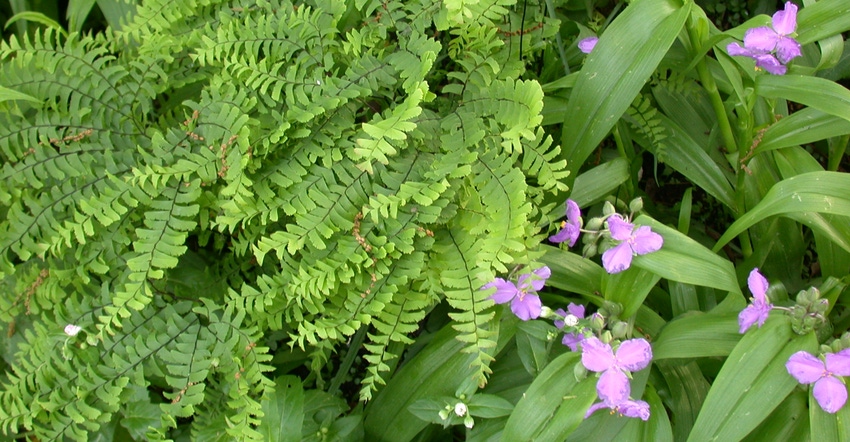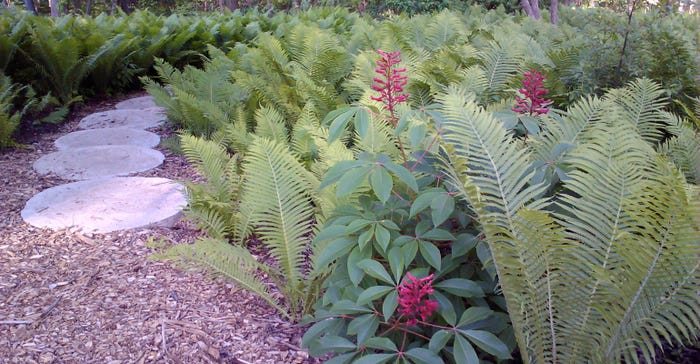September 30, 2021

If there is one group of plants that is hard to come by and underutilized by gardeners, it is native ferns.
Although many ferns are easy to grow at home in shade, they are difficult to propagate commercially. Spore production is tricky, and root division is a slow process. That makes production expensive.
Here are six native ferns to plant around your farm property:
1. Sensitive fern. The easiest native fern to grow is sensitive fern. Lucky for us, it is also the most commonly available species. It is sensitive because the leaves die back with the first light autumn frost. It is easy to grow because it tolerates average-to-wet soils in part-shade to shade.
It can even tolerate part-sun to sun if growing in permanently wet soil such as at the edge of a pond or lake. It works well in shady rain gardens and swampy woodlands. It colonizes into a dense groundcover in part-shade, but is more open in denser shade. It performs well with other shade-loving species such as wild geranium, Virginia knotweed and Solomon’s seal.
2. Ostrich fern. This is another easy-to-grow fern species. This one prefers greater moisture, so water it in summer when it’s dry. This species also spreads by underground runners to form small colonies. The fiddleheads (coiled leaves that emerge in early spring), picked in early April when they are 1 to 2 inches tall, are edible. Steam or sauté them in butter, and add to a cream sauce and your favorite pasta.

LONG NECK: The ostrich fern is one that grows tall and demands attention, much like the bird that carries its name. It also is an edible native plant.
3. Spleenwort fern. This is a favorite ornamental fern with narrow leaves. The spleenwort is a clump-forming fern that grows 2 to 3 feet tall and has clean foliage all summer. It prefers shade or part-shade (with little or no direct sun) and moist soil. It tolerates summer drought better than most ferns, but I water during dry periods to keep it looking good. This one combines well with little-flower alumroot and golden groundsel.
4. Maidenhair fern. This native fern has delicate, fine-textured fronds. In nature, it grows on north-facing slopes, and it prefers good drainage, plenty of shade and regular moisture. Maidenhair mixes well with spring ephemerals (plants that flower in spring and go dormant by early summer) such as celandine poppy, Jacob’s ladder and Virginia bluebells.
5. Christmas fern. One of the most drought-tolerant species is Christmas fern. Christmas fern is semi-evergreen, staying green through most of winter. By late winter, the leaves turn brown, just before new spring growth emerges. In nature, it grows on steep dry banks along creeks where leaf litter blows away, and will tolerate growing in well-drained garden soil. In gardens, remove tree leaf litter from Christmas ferns during winter months to prevent smothering.
6. Broad beach fern. This is a slow colonizer that prefers wooded slopes where soils are sandy, acidic and dry. Get a soil test to determine your pH. Acid soils (an indicator of sandy or cherty soils) are in the range of 4 to 6, whereas soils above 7 are alkaline (indicating limestone soils). If you have an acidic woodland, you will be able to grow lowbush blueberry, mountain azalea, dittany and cream wild indigo, to name a few.
Caring for ferns
Nothing beats the shade in summer, and a patch of native ferns. They add graceful beauty and a sense of wonder because they appeared on Earth well before the flowering plants. Most ferns need regular watering in summer, but in general, shade gardens are easier to maintain than sunny ones.
Ferns don’t spread from seed, unlike flowering plants, because ferns produce spores that rarely germinate or spread in gardens. If they do germinate, consider yourself lucky to have the perfect place for native ferns.
If you are looking for native ferns to buy, inquire with Grow Native! professional members, who may carry some stock. See grownative.org, Resource Guide.
As with all native plants, digging ferns from the wild depletes their populations, and is prohibited on private land without permission. Digging plants on public land is illegal. Buying propagated native plants, including ferns, protects wild populations. Wishing you many fancy fronds and fiddleheads!
Woodbury is a horticulturalist and curator of the Whitmire Wildflower Garden at Shaw Nature Reserve in Gray Summit, Mo., where he is an adviser to the Missouri Prairie Foundation’s Grow Native! program.
About the Author(s)
You May Also Like




